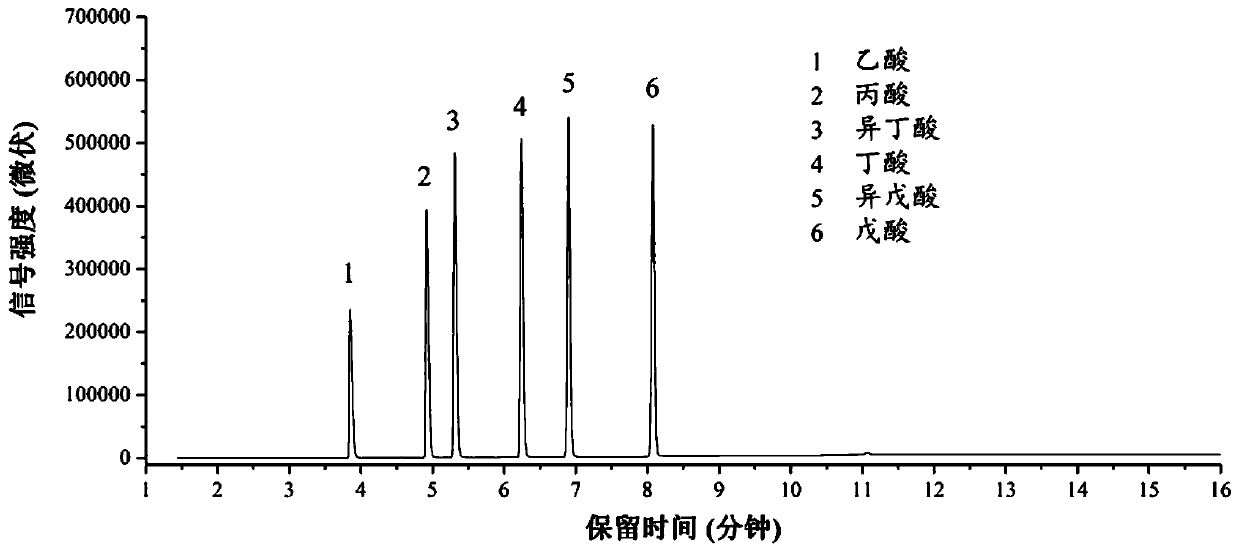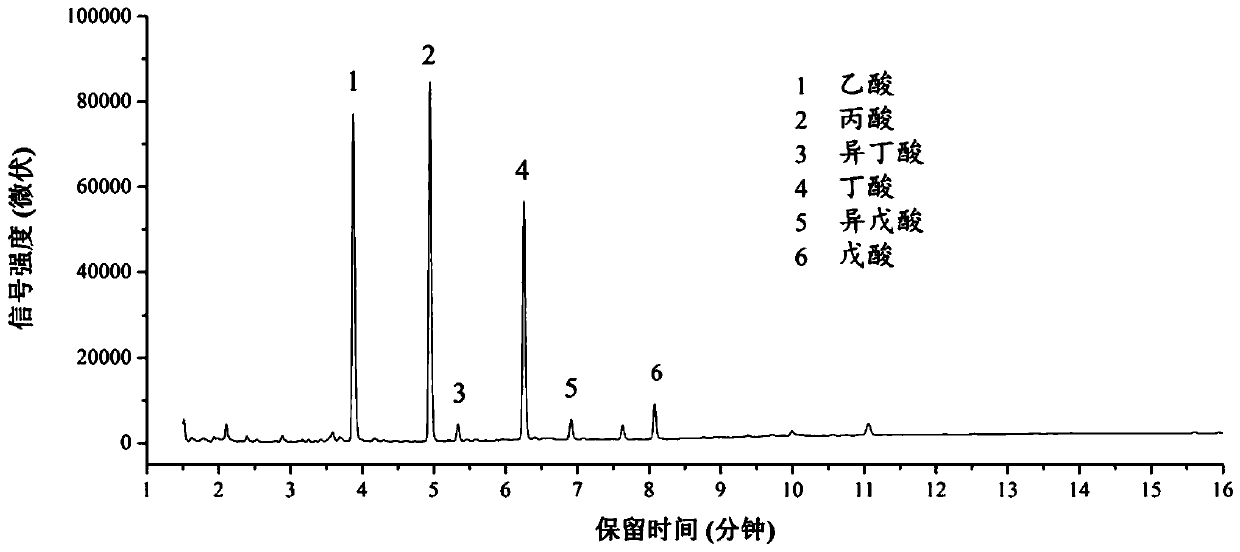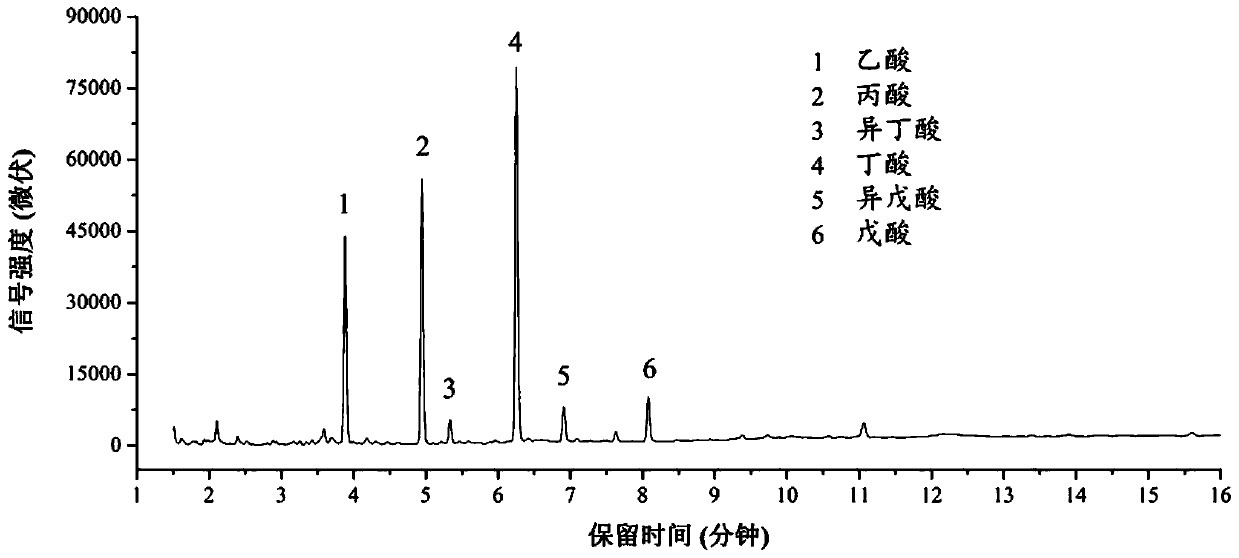Method for determining short chain fatty acid content in intestinal contents or excrement
A technology for short-chain fatty acids and content, which is used in measurement devices, instruments, scientific instruments, etc., can solve the problems of damage to the detector, low extraction rate of short-chain fatty acids, and low efficiency of ultra-pure water extraction of short-chain fatty acids, etc. effect of loss
- Summary
- Abstract
- Description
- Claims
- Application Information
AI Technical Summary
Problems solved by technology
Method used
Image
Examples
Embodiment 1
[0029] Embodiment 1: Determination of short-chain fatty acid mixed standard standard curve
[0030]The sample is a mixed standard solution of short-chain fatty acids, and the concentration range of each short-chain fatty acid standard product in the standard curve is set as: 0.015~0.200 μL / mL (short-chain fatty acid standard product: solvent; V / V); The mass volume concentration range of each short-chain fatty acid in the corresponding standard product is: acetic acid 15.738-209.840 μg / mL, propionic acid 14.850-198.000 μg / mL, isobutyric acid 14.235-189.800 μg / mL, butyric acid 14.460-192.800 μg / mL mL, isovaleric acid 13.962-186.160 μg / mL, valeric acid 14.085-187.800 μg / mL. Set 7 concentrations of each standard analyte (for example, 0.015, 0.025, 0.050, 0.075, 0.100, 0.150, 0.200 μL / mL); each concentration of standard analyte was determined in parallel three times. Take 3 times of the standard deviation of the peak area as the lower limit of detection (LOD) of each short-chain f...
Embodiment 2
[0041] Embodiment 2: Determination of the content of short-chain fatty acids in the colon contents of SD rats
[0042] (1) Sample dissolution: Mix about 50 mg of sample with 500 μL of saturated sodium chloride solution, add 0.1 times the volume of saturated sodium chloride in 10% sulfuric acid solution to acidify, and oscillate to fully dissolve the sample;
[0043] (2) Extraction of short-chain fatty acids: add 800 μL of ether, shake for 30 s, and fully extract the short-chain fatty acids in the sample;
[0044] (3) Sample preparation: centrifuge the extract at 12 000r / min, 4°C for 10min, take the supernatant, add 0.25g of anhydrous sodium sulfate solid, shake for 30s, centrifuge at 4500r / min, 4°C for 3min, remove traces Measure the water, pass through a 0.22μm organic microporous membrane, and enter the chromatograph for analysis;
[0045] (4) Determination by gas chromatography: Chromatographic column: Agilent DB-FFAP strong polar capillary column. The experimental data w...
Embodiment 3
[0052] Embodiment 3: Measuring the content of short-chain fatty acids in the fresh feces of SD rats
[0053] (1) Sample dissolution: Mix about 50 mg of sample with 500 μL of saturated sodium chloride solution, add 0.05 times the volume of saturated sodium chloride in 10% sulfuric acid solution to acidify, and oscillate to fully dissolve the sample;
[0054] (2) Extraction of short-chain fatty acids: add 800 μL of ether, shake for 30 s, and fully extract the short-chain fatty acids in the sample;
[0055] (3) Sample preparation: centrifuge the extract at 12 000r / min, 4°C for 10min, take the supernatant, add 0.25g of anhydrous sodium sulfate solid, shake for 30s, centrifuge at 4500r / min, 4°C for 3min, remove traces Measure the water, pass through a 0.22μm organic microporous membrane, and enter the chromatograph for analysis;
[0056] (4) Determination by gas chromatography: Chromatographic column: Agilent DB-FFAP strong polar capillary column (column parameters: 30m×0.25μm×0.2...
PUM
 Login to View More
Login to View More Abstract
Description
Claims
Application Information
 Login to View More
Login to View More - R&D
- Intellectual Property
- Life Sciences
- Materials
- Tech Scout
- Unparalleled Data Quality
- Higher Quality Content
- 60% Fewer Hallucinations
Browse by: Latest US Patents, China's latest patents, Technical Efficacy Thesaurus, Application Domain, Technology Topic, Popular Technical Reports.
© 2025 PatSnap. All rights reserved.Legal|Privacy policy|Modern Slavery Act Transparency Statement|Sitemap|About US| Contact US: help@patsnap.com



